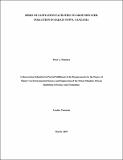| dc.description.abstract | Despite of its importance for human consumption groundwater resource is under threat of
overexploitation and pollutions. The study to assess the risks of sanitation facilities to
groundwater pollution was carried out in the small town of Babati in Manyara, Tanzania. The
identification of all the wells in the vicinity of town and their proximity within 60 m radius to
each recorded. Water sampling from the selected wells was done and the tests for nitrate,
nitrites, total phosphorus, Phosphates, Chemical oxygen demand, fluorides and microbial
(Fecal and Total coliforms) levels performed. Methods used included Diazotization,
Cadmium reduction, Ascorbic acid, ion selective membrane and membrane filtration (MF)
for nitrites, phosphates, fluorides and microbes respectively. Geographic information System
(GIS) was used to geo-reference the water sources and water quality data were analyzed by
using OriginPro8 SR0 v8.0724 software. The results revealed higher fecal coliform in
shallow wells both used bucket and pumps to draw water. The maximum mean level of FC
was 85.81CFU/100 mg/l and NO3 was 65.48 mg-NO3/l. Boreholes indicated lower nitrate
levels than National and WHO standards and were all free of fecal coliforms. Other
parameters were all within recommended limits for all wells tested. The evaluation of the
potential contamination pathways revealed that the shallow well depth mean value was
10.40±0.30 m (N=366 P˂0.05), 70% were unlined and 19% were uncovered. About 74% of
the wells were within 30m of sanitation facilities, of which 60% were traditional pit latrines.
The findings reveal that most shallow wells (64%) are polluted and the aquifer of Babati
classified as a moderately vulnerable to contaminations. The results showed a very high risk
in some parts of Kiongozi in Maisaka ward and some other parts in Babati and Bagara wards.
Most location of the locations found with shallowest well depths also indicated the increased
risk of groundwater pollution (Fig. 17). Therefore it is prudent that the community avoids
relying on shallow wells and boiling of domestic water before consumption. Authority should
also seek for a simple and affordable way/strategy to that will improve sanitation facility
designs, distributions. Also to establish adequate regulations to overcome environmental
contamination challenges, persistence pollutant chemicals and resistance antibiotics through
drinking water sources in developing countries like Tanzania. | en_US |

